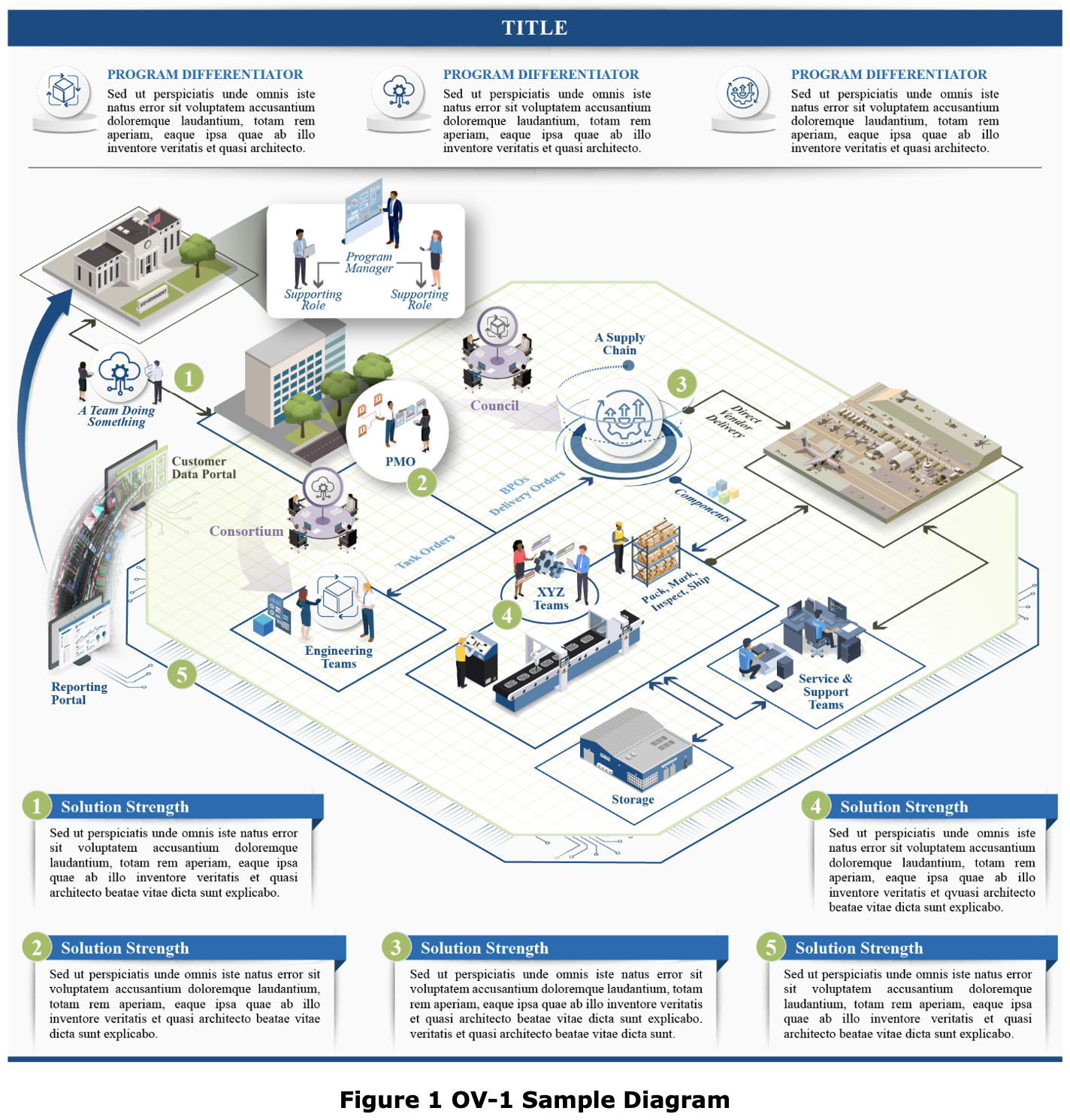The Science and Art of an OV-1 Diagram

An OV-1 diagram/graphic (or Operational Viewpoint) loosely refers to any singular overarching graphic that frames a proposal. The U.S. Department of Defense (DoD) Architectural Framework (DoDAF) Version 2.02 Deputy Chief Information Officer defines it as follows:
“The OV-1 describes a mission, class of mission, or scenario. It shows the main operational concepts and interesting or unique aspects of operations. It describes the interactions between the subject architecture and its environment, and between the architecture and external systems.”
The OV-1 graphic can excite your customers and team and rally people around your solution and concepts. Since building an OV-1 is both an art and a science, success is somewhat subjective. Most OV-1s share these common elements.
- Compelling: Grabs the reader’s attention and quickly communicates the proposal’s solution and benefits.
- Substantial: Presents a visually stunning and substantial diagram, frequently drawn in a 3D or isometric style.
- Comprehensive in scope: Covers the scope of the technical requirements at a high level and provides a detailed description of the requirements in the proposal narrative. For example, if you are selling fire, then fire should be on the diagram, but not the whole process of gathering the wood, laying the sticks, finding kindling, lighting the fire, and keeping the fire burning. Editing the OV-1 to get the right balance of content specificity is hard but necessary.
- Accurate: Presents an accurate and reliable 60,000-foot view of the solution. It is consistent with the engineered solution, but it is not an engineering diagram.
- Meta: Shows each significant component in the context of the whole solution.
- Impactful: Depicts a powerful solution, as in the case of a warfighter overcoming an enemy or delivering improved services faster, better, and cheaper.
- Broad: Resonates with a broad audience with diverse needs and balances graphical and textual elements (that balance is different depending on the solution details.)
Sample OV-1 Diagram
Figure 1 presents a generic example of an OV-1 diagram meeting the abovementioned criteria. The strengths and program-level impacts are explicitly called out, so the OV-1 not only communicates your solution, it sells your value.

Figure 1 OV-1 Sample Diagram
Process for Creating an OV-1 Diagram
Although each OV-1 diagram is different, you can use analogous processes to build them and yield superior results.
- Use the guidelines: Be mindful of the criteria listed above. They are foundational design considerations.
- Stay multifunctional: Create OV-1 diagrams that communicate to a diverse audience of experts as well as non-experts.
- Fail fast: Get something onto paper quickly and iterate on it over time until you have a perfect diagram that depicts your solution.
- Review: Conduct team reviews and use the feedback to improve the diagram. If reviewers must study the OV-1 to understand it, it’s unclear.
- Edit: Edit out content when the OV-1 looks cluttered. Resist the urge to put everything into the graphic that reviewers suggest. OV-1 diagrams are an instance where less is more is true.
- Start over (optional): Don’t be afraid to start over if the OV-1 diagram isn’t working—or pause, step back, and reconsider the structure and intent. If the OV-1 is clear to you but not to others, listen to the feedback. Sometimes, the content is there, but the structure or presentation of the content is wrong.
- Render it professionally: Explain your concept and ideas for the diagram to the graphic artist. If the concept doesn’t make sense to the graphic artist, it likely won’t make sense to your audience.
- Finish: Don’t miss the finish line. Done happens when everyone is happy, or you’re out of time or resources.
- Use it: Present your OV-1 to your customer for feedback and use the customer’s feedback to improve your solution.
How Do You Know Your OV-1 is Successful?
Ultimately, you win, and your OV-1 diagram is cited as a strength in your debrief! Until then, a successful OV-1 generates an understanding of and enthusiasm for your overall solution and a unified vision for your team.
A successful OV-1 diagram can help you gain mindshare and other favorable biases with your customer. Under the best circumstances, the customer may get excited about the OV-1 diagram and start working with you to refine it.
By Bill Szymanski, Lohfeld Consulting Principal Consultant
Lohfeld Consulting Group has proven results specializing in helping companies create winning captures and proposals. As the premier capture and proposal services consulting firm focused exclusively on government markets, we provide expert assistance to government contractors in Capture Planning and Strategy, Proposal Management and Writing, Capture and Proposal Process and Infrastructure, and Training. In the last 3 years, we’ve supported over 550 proposals winning more than $170B for our clients—including the Top 10 government contractors. Lohfeld Consulting Group is your “go-to” capture and proposal source! Start winning by contacting us at www.lohfeldconsulting.com and join us on LinkedIn, Facebook, YouTube(TM) and X (Twitter).
Paperback or Kindle
10 steps to creating high-scoring proposals
by Bob Lohfeld
contributors Edited by Beth Wingate
Subscribe to our free ebrief
Teaming friends, frenemies, and enemies—12 tips to mitigate harmful effects
Did you know that contracting officers spend up to 20% of their time mitigating disputes between teaming partners? In an informal poll we conducted on LinkedIn last month, 40% of respondents classified their teaming partners as “frenemies” on their last bid.
Explore Further
- Advice (446)
- AI (5)
- APMP (17)
- Business Development (198)
- Capture Management (197)
- Favorite Books (5)
- Go-to-Market (27)
- Graphics (6)
- Lohfeld Books (3)
- Past Performance (58)
- Post-submission Phase (15)
- Pre-RFP Preparation (211)
- Proposal Management (270)
- Proposal Production (60)
- Proposal Reviews (27)
- Proposal Writing (77)
- Pursuit Phase (89)
- Research Report (2)
- Resources (60)
- Tools & Tips (259)
- Training (10)
- Uncategorized (220)

Sign Up for INSIGHTS and Download your FREE book
We'd love to help you with your proposals. Enjoy our complimentary Lohfeld Consulting Group Capture & Proposal Insights & Tips book with your FREE subscription to our Insights Newsletter.
GET YOUR FREE BOOK




